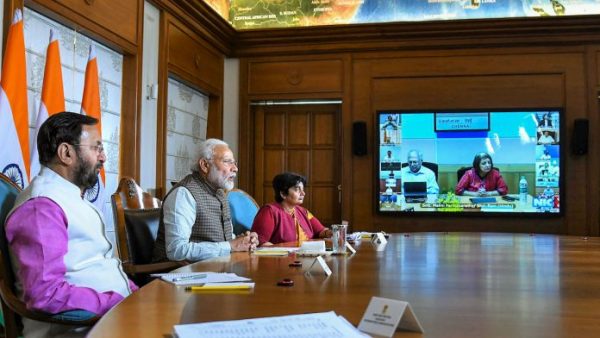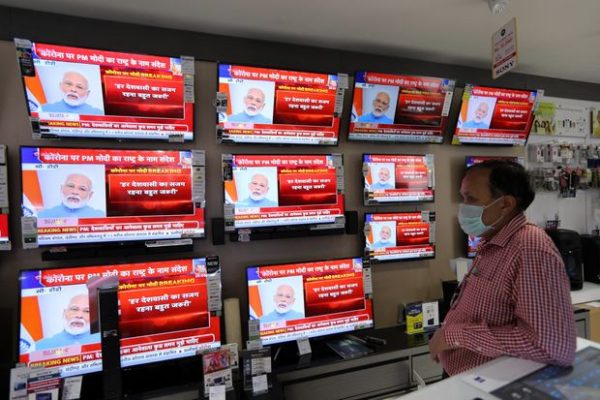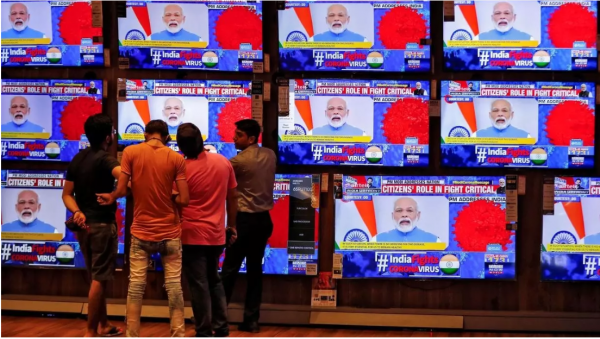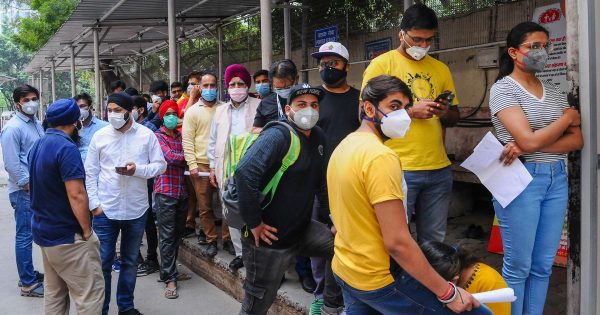
The media may never be the same in the aftermath of the COVID-19 pandemic and the economic collapse that will accompany and follow the health emergency across the world, and in India. Many governments across the globe are claiming that state control over information flows is essential, not just to combat fake news over the internet and social media, but also to confront and combat the ongoing multi-facetted crisis.
In this country, there is a distinct possibility that rules could be interpreted and laws amended to enable the ruling regime to curb freedom of expression, especially information in digital media. This is not to argue that strict action should not be taken against purveyors of disinformation. But, there is a clear and present danger that the cure for fake news as proposed by authoritarian regimes, including the one in India, could prove worse than the disease.
On the evening of March 31, a bench of the Supreme Court of India headed by the Chief Justice of India S.A. Bobde and including Justice L. Nageswara Rao issued the following direction:
“The migration of large number of labourers working in the cities was triggered by panic created by fake news that the lockdown would continue for more than three months. Such panic driven migration has caused untold suffering to those who believed and acted on such news. In fact, some have lost their lives in the process. It is therefore not possible for us to overlook this menace of fake news either by (the) electronic, print or social media. Section 54 of the Disaster Management Act, 2005 provides for punishment to a person who makes or circulates a false alarm or warning as to disaster or its severity or magnitude, leading to panic. Such person shall be punished with imprisonment, which may extend to one year or with fine.”
The court quoted a recent statement by Dr Tedros Adhanom Ghebreyesus, Director General, World Health Organisation (WHO): “We are not just fighting an epidemic; we are fighting an infodemic. Fake news spreads faster and more easily than this virus, and is just as dangerous.”
The 39-page status report, signed by the Union Home Secretary Ajay K. Bhalla, and submitted by the government of India to the apex court the same day concluded by stating:
“In an unprecedented situation of this nature, any deliberate or unintended fake or inaccurate reporting either in electronic, print or social media and, particularly, in web portals, has a serious and inevitable potential of causing panic in large sections of society… any panic reaction by any section of society could not only be harmful for such (a) section but would harm the entire nation.”
The government urged the Supreme Court to direct the media not to “print, publish or telecast anything without first ascertaining the true (and) factual position” provided by the central government.
On the evening of March 23, less than 24 hours after Prime Minister Narendra Modi effusively praised the “tireless efforts” of the media for providing a “great service to the nation” by “understanding the gravity of the pandemic threat” and appreciating “the role played by the news channels in spreading awareness” about social distancing, police personnel in the national capital of Delhi and in Hyderabad assaulted at least four journalists who were reporting on the countrywide lockdown.
In the early afternoon of March 24, Naveen Kumar, a reporter with the leading Hindi television news channel Aaj Tak said he was abused and beaten up by cops in Delhi Police uniforms while on his way to work. He said that he was at the Delhi-Noida check-post when his car was stopped. Despite showing his identity card, he was pushed inside a van where three policemen uttered expletives and punched him. He said he was let off after others gathered around the van and witnessed him being assaulted.
The same night, policemen physically assaulted three journalists in Hyderabad: Ravi Reddy, bureau head of The Hindu, who was stopped at a barricade and roughed up while he was returning home from work; Mendu Srinivas, political bureau chief of the Telugu daily Andhra Jyothi was bashed up and insulted, as was Mohammed Hussain, a journalist with the English website of the Urdu daily Siasat.
A representative of the Committee to Protect Journalists (CPJ), a New York-based independent, non-profit, non-government organisation that seeks to promote media freedom and defend the rights of journalists, sent messages to the spokespersons of the police departments in Delhi and Hyderabad seeking their views on what had been reported by the four journalists, but received no responses.
Even if these are isolated instances, if police personnel can act in the manner they did in the capital of India and the capital of Telengana, should one be surprised by the manner in which cops are seen in videos recorded on mobile phones, behaving worse than criminals with the poor and the underprivileged?

Indian Media in the Post-Truth Era
The paradox of the post-truth world we are living in was epitomised by two connected developments: a letter sent by the Ministry of Information & Broadcasting (I&B) on the day the Prime Minister uttered homilies in a video-conference he conducted with a select group of owners and representatives of media organisations from across the country. Firstly, the following is an excerpt of what Modi said, according to a statement issued by the Prime Minister’s Office:
“The tireless efforts of the reporters, camerapersons and technicians are a great service to the nation. The media should counter pessimism and panic through positive communication. COVID-19 is a lifetime challenge and it needs to be tackled through new and innovative solutions.”
The letter itself, sent by Gopal Sadhwani, Director, Information and Broadcasting, to the Chief Secretaries of all states and Union territories, said that news agencies, television channels, teleport operators, Digital Satellite News Gathering (units) (DSNGs), Direct to Home (DTH) and Headend-in-the-Sky (HITS) multi-system operators (MSOs), cable operators, FM (frequency modulation) radio and community radio stations provide services that are of “utmost importance to ensure timely and authentic information dissemination.”
The letter said that all operators of such facilities and intermediaries in the chain should be permitted to remain operational, and that the movement of the accredited staff of service providers, as well as that of vehicles carrying media-persons and DSNGs units should be allowed without hindrance. Sadhwani added:
“The proper functioning of these networks is required not only to create awareness among people and to give important messages but also to keep the nation updated of the latest status…fake and false news need to be avoided and good practices need to be promoted…”
On March 23, the Prime Minister said news channels provided “vital” feedback on which “the government is constantly acting,” and went into details of how reporters should work. He suggested that the channels should provide dedicated boom microphones to field reporters so that they could maintain a distance of at least a metre while conducting interviews.
The most detailed account of what transpired at the interaction between Modi and the owners and editors of more than 20 media organisations which publish and broadcast in eleven different languages from different parts of India, barely six hours before the three-week countrywide lockdown was announced, has been written by Sagar (with inputs from Mehak Mahajan) in The Caravan. Here’s a long extract:
“Through the interaction, the prime minister’s website reported, Modi sat with a notebook and pen and could be seen taking down notes when the participants offered suggestions. The exercise almost represented the journalists as a part of the government, as opposed to being members of an institution whose job entailed questioning the government on its shortcomings. Instead, most of the owners and editors appeared grateful for the exchange. The prime minister’s website reported that the journalists committed to “work on the suggestions of the prime minister to publish inspiring and positive stories” about COVID-19. After the interaction, some owners and editors who were present in the meeting took to Twitter to thank the prime minister for making them a part of the videoconference and seeking their opinions, while others published reports on the meeting on the front page the next day, with photos of themselves and Modi on the television screen.
Following the conference, I spoke to nine owners and editors of media houses, from both national and regional media, who participated in the interaction. Almost all of them appeared enamoured by what some described as an important “gesture” from Modi, of considering their opinions.
I asked the owners and editors whether their interaction with Modi, given his suggestion to publish positive stories, would affect their editorial judgment while publishing a critical piece on the government’s policies for fighting the novel coronavirus. Only two of them explicitly said they would publish a critical piece despite the interaction, while three said they would not do so but for different reasons, not due to the interaction. One of them asked me omit references to such question while referring to our conversation in this report. Others refused to comment at all.
But a scrutiny of their subsequent COVID coverage revealed that Modi’s words of caution had done their job—the newspapers were evidently uncritical of the government’s response to the virus. The coverage of the public-health crisis by these organisations contained little mention of the poor planning and disastrous implementation of the lockdown, or the government’s failure to prepare for the pandemic, such as stockpiling crucial medical equipment for the healthcare workers despite early warnings by the World Health Organisation.
The Caravan report concluded that going by the responses of the owners and editors of media organisations spoken to, and the subsequent coverage of events by their groups, “it appeared that the prime minister inspired most of them to abandon a basic tenet of journalism—to speak truth, not positivity, to power.”

Lessons from the Emergency
Responding to Tuesday’s Supreme Court judgment, senior journalist Barkha Dutt stated on Twitter that while there was nothing wrong in seeking the government’s response to events and developments, the question remains as to what journalists should do when there is no response from the government. She wondered: “… why should we be silent? This will kill reportage.”
Senior journalist Tavleen Singh, once a Modi supporter and now his critic, recalled what Indira Gandhi said after the Emergency: “Asked what her biggest mistake was she said: press censorship.”
Indira Gandhi did not put just editors and journalists, but also her political opponents behind bars. Three days after the Emergency was imposed on June 23, 1975, a short ‘obituary’ appeared in the ‘classified’ section of the Times of India (that toed the government line). It later transpired that the obit, which was inspired by an advertisement in a Sri Lankan newspaper, was placed by Ashok Mahadevan, who was then the India editor of the Reader’s Digest. It read:
“O’Cracy, D.E.M., beloved husband of T.Ruth, father of Hope, Faith and Justicia, expired on June 26.”
Almost four and a half decades later, the Modi regime has acted differently but with the same consequences: curbing criticism of the government. The Prime Minister has interacted with the media on his terms, under controlled circumstances. After May 2014, he has not granted a single interview to a journalist who would ask him difficult questions. Every single interaction he has had with the ‘fourth estate’ has been closely and carefully orchestrated.
Much of the media in the world has been financially squeezed because of the double whammy of the economic recession (which has reduced or slowed down expenditure on advertising) and the exponential rise in the use of the social media on the internet. In addition, in India, the growing dependence on government munificence has ensured that much of the media is subservient to the ruling dispensation.
To top this, the Modi government introduced the Registration of Books and Periodicals Bill in 2019 to amend the colonial era Press and Registration of Books Act of 1867 and capped foreign direct investment in digital media organisations (to the support of a large segment of the mainstream corporate media). Both moves have the potential to constrain freedom of expression – these merit longer discussions that will take place later.
Anchal Bhateja, a student at the National Law School of India University, Bengaluru, wrote an article for Newsclick that began by quoting Abraham Lincoln, who probably foresaw the 21st Century’s post-truth era, when he said: “Let the people know the facts and the country will be safe.”
She wrote:
“Today, when millions are fighting the rapid spread of Covid-19 and many thousands have succumbed too, the public’s indispensable need is for a steady diet of the right facts. For that is what will help the citizenry ensure its own safety, not a steady diet of Ramayana TV serials from the pre-Cable TV and pre-Netflix era. Instead, a tremendous amount of misinformation is far too conveniently accessible, but hardly any way to assess the veracity of it all.
Fake news requires no more than a click on the ‘forward’ button on the bottom right corner of WhatsApp, through which a user can send a message to nearly 1,300 people. Whereas on Facebook, a single post can reach as many people as one wants, with just a click. This can take just a millisecond. However, as per Alt-News, an acclaimed fact-checking website, the process of debunking fake information is elaborate and requires intricate tasks, such as using image search tools, extensive online research, reaching out to local authorities, referring to primary data and so on. This takes a lot more time than to just click the forward button.
Fake news mushrooms like wild fire also because of ‘sender primacy’, where a person shares a particular information because it is being endorsed by someone they idolise or respect; ‘selective consumption’, wherein people believe incomplete information thinking that it is complete; ‘network effect’, where a piece of news goes viral after it reaches a tipping point; and the ‘post-truth effect’, which has people believe what they see or hear because it matches their political ideology and socialisation.
Social media inboxes, Facebook walls, WhatsApp chats, Twitter pages and a number of other popular and lesser-known sites and apps are flooded with information about the novel coronavirus, its origin, cures and prevention. Some are fathoms away from truth or logic, and carry the potential for unimaginable harm to our economic and social health.
She concluded her article suggesting that it is “probably the right time for the government to revisit its Information Technology Intermediaries Guidelines (Amendment) Rules, 2018 and take steps to begin identifying and disabling harmful content and preventing fake news from spreading.”

Countering the Infodemic
There is an important point to be noted. In India – as in many other countries – supporters of ruling right-wing regimes have been at the forefront of spreading fake news, misinformation and propaganda. WhatsApp, that reportedly has 400 million users in India, has taken the lead in this regard in the country. Despite claims to the contrary, no serious effort has been made to curb the powers of the digital monopolies to influence public opinion by spreading disinformation.
The BJP and its supporters have, more than others, been able to use platforms like WhatsApp and Facebook to its advantage. (See the book co-authored by this writer with Cyril Sam titled “The Real Face of Facebook in India: How Social Media have become a Propaganda Weapon and Disseminator of Disinformation and Falsehood,” self-published in April 2019.)
Across the world, the pandemic has contributed to journalists critical of the establishment being harassed, intimidated, jailed (there are over 250 of them) and killed because governments are implementing sweeping restrictions under the guise of combating misinformation and fake news. Joel Simon, executive director, Committee to Protect Journalists (CPJ), wrote in the Columbia Journalism Review on March 25:
“There’s a growing acceptance of the false view that the dramatic measures (to curb the working of the media) required may come at the expense of civil liberties and democratic rights… Amid efforts to beat back a global pandemic of a kind unseen in more than a century, and to prop up a global economy on the brink of depression, it’s hard to focus on long-term consequences. But we must be mindful that when we get to the other side of the pandemic, we may be left with a narrative, being written by China, that government control over information was essential to combating the crisis. That would be a devastating blow to the global information system, one that could endure even as the memories of the terrible pandemic we are currently facing slowly fade.”
To return to the question raised in the beginning of this article, as to whether India has moved towards the situation that prevailed in the country in the mid-1970s, during the Emergency when Indira Gandhi’s government muzzled the press. The answer is unfortunately an unequivocal “yes.” But, this is a different kind of an Emergency. Modi does not acknowledge mistakes, leave alone repent for them like Indira Gandhi did four decades ago. A notable example: demonetisation.
During the Emergency, only a few publications, such as The Indian Express, The Statesman and Himmat opposed the government of the day. The Express published a blank space on its editorial pages in protest. As I was finishing this article on Wednesday, April 1, I learned that the Express has announced a salary-cut for many of its staffers.
After Indira Gandhi’s electoral defeat in March 1977, Lal Krishna Advani, the Information & Broadcasting Minister in Morarji Desai’s government was asked why so many editors had so meekly capitulated before the Emergency regime. Today’s nonagenarian “angry old man” of the Bharatiya Janata Party then famously responded: “When they were asked to bend, they crawled.”
From June 1975 till January 1977, almost the entire press in India was slavish in its praise for the then Prime Minister Indira Gandhi. Today Prime Minister Modi has no reason to worry in the least. The country’s media barons are bending without even being asked to crawl. Forget about holding truth to power or playing the role of adversaries or antagonists to those in power and authority. Most of the representatives of the so-called ‘fourth estate’ in India are little different from those who work in advertising agencies or public relations firms.
These are indeed difficult times for what remains of the independent media in India and there is a distinct possibility that the situation would worsen in the time to come. What has happened in The Indian Express may just be a beginning.




